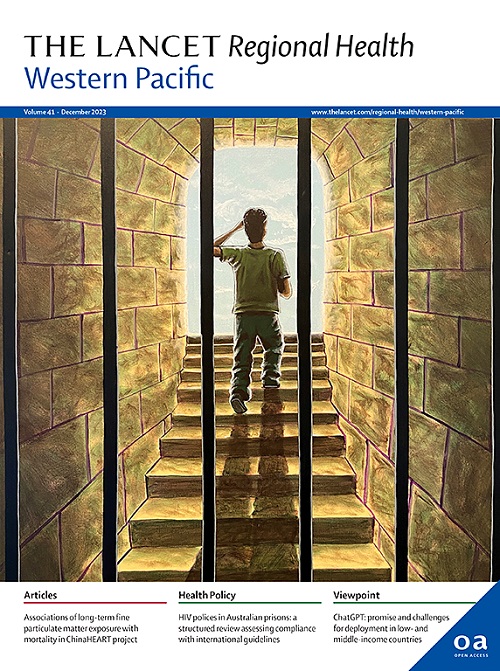Impact of rapid temperature fluctuations on acute stroke risk: a nationwide case-crossover study from 2001 to 2020
IF 7.6
1区 医学
Q1 HEALTH CARE SCIENCES & SERVICES
引用次数: 0
Abstract
Background
Climate factors greatly affect cardiovascular health, with stroke ranking among serious global concerns. However, the impact of rapid temperature fluctuations on stroke risk remains underexplored. Given Taiwan's aging population and the intensifying effects of climate change, understanding influence of ambient temperatures on stroke risk is crucial for public health protection. This study aimed to explore the link between ambient temperature, sudden day-to-day temperature changes, and stroke onset in Taiwan, taking air pollutants into consideration.
Methods
We conducted a time-stratified case-crossover study from 2001 to 2020 using Distributed Lag Nonlinear Models (DLNM) within conditional logistic regression to examine lagged associations between temperature parameters and stroke risk. We analyzed associations separately for total stroke, ischemic stroke, and hemorrhagic stroke to identify potential differences in risk patterns, using odds ratios (ORs) relative to the temperature associated with the lowest stroke risk. Data from the National Health Insurance Research Database (NHIRD) identified the study population, including 1,100,074 first-time stroke emergency events and self-matched with 2,200,148 non-stroke onset dates as controls. The primary exposure assessments included daily temperatures (mean, maximum, and minimum) and temperature fluctuations (diurnal temperature range (DTR), sudden day-to-day temperature increases (TDI), and sudden day-to-day temperature decrease (TDD)), adjusted for air pollutants (PM2.5, O3, SO2, and NO2), and rainfall. Lag periods up to 13 days prior to the corresponding event or control days were used to examine the lag effect of stroke risk.
Findings
Through DLNM exposure-lag-response effect analysis after adjustment for PM2.5, O3, SO2, NO2, and rainfall, the study revealed that when TDI exceeded 6 °C, the risk of ischemic stroke more than doubled compared to the lowest risk temperature (OR: 2.173, 95% CI: 1.887, 2.501). The risk continued to rise until 9 °C, with a second peak observed when TDI exceeded 16 °C (OR: 2.096, 95% CI: 1.733, 2.535). Conversely, TDD exceeding 14 °C was linked to heightened hemorrhagic stroke risk (OR: 2.187, 95% CI: 2.055, 2.326). Additionally, daily maximum temperature exceeding 35 °C was associated with an increased stroke risk, primarily affecting ischemic stroke, while daily minimum temperature below 16 °C was strongly associated with a doubled risk of hemorrhagic stroke.
Interpretation
Our findings indicate that sudden day-to-day temperature increases and decreases are significant predictors of stroke onset. These results emphasize a noteworthy relationship between temperature and stroke risk over consecutive days, supporting interventions aimed at reducing stroke incidence.
Funding
This research was supported by the National Science and Technology Council (NSTC), Executive Yuan, Taiwan, grant No. NSTC-111-2119-M-865-002.
快速温度波动对急性卒中风险的影响:2001 - 2020年全国病例交叉研究
背景气候因素对心血管健康有很大影响,其中中风是全球严重关切的问题之一。然而,气温快速波动对中风风险的影响仍未得到充分研究。鉴于台湾人口老龄化和气候变化影响的加剧,了解环境温度对中风风险的影响对保护公众健康至关重要。本研究旨在探讨台湾地区环境温度、日间气温骤变与中风发病之间的联系,同时考虑空气污染物。我们分别分析了总中风、缺血性中风和出血性中风的相关性,使用与中风风险最低的温度相关的几率比 (OR) 来识别风险模式的潜在差异。国家健康保险研究数据库(NHIRD)的数据确定了研究人群,其中包括 1,100,074 例首次中风急诊事件,并与 2,200,148 例非中风发病日期自我匹配作为对照。主要暴露评估包括每日气温(平均气温、最高气温和最低气温)和气温波动(昼夜温差(DTR)、逐日气温骤升(TDI)和逐日气温骤降(TDD)),并根据空气污染物(PM2.5、O3、SO2 和 NO2)和降雨量进行了调整。研究结果通过对 PM2.5、O3、SO2、NO2 和降雨量进行调整后的 DLNM 暴露-滞后-反应效应分析表明,当 TDI 超过 6 ° C 时,缺血性中风的风险比最低风险温度增加了一倍多(OR:2.173,95% CI:1.887,2.501)。风险持续上升,直至 9 °C,当 TDI 超过 16 °C时观察到第二个高峰(OR:2.096,95% CI:1.733,2.535)。相反,TDD 超过 14 ° C 与出血性中风风险增加有关(OR:2.187,95% CI:2.055,2.326)。此外,日最高气温超过 35 ° C 与中风风险增加有关,主要影响缺血性中风,而日最低气温低于 16 ° C 与出血性中风风险加倍密切相关。这些结果强调了连续数日气温与中风风险之间值得注意的关系,为旨在降低中风发病率的干预措施提供了支持。
本文章由计算机程序翻译,如有差异,请以英文原文为准。
求助全文
约1分钟内获得全文
求助全文
来源期刊

The Lancet Regional Health: Western Pacific
Medicine-Pediatrics, Perinatology and Child Health
CiteScore
8.80
自引率
2.80%
发文量
305
审稿时长
11 weeks
期刊介绍:
The Lancet Regional Health – Western Pacific, a gold open access journal, is an integral part of The Lancet's global initiative advocating for healthcare quality and access worldwide. It aims to advance clinical practice and health policy in the Western Pacific region, contributing to enhanced health outcomes. The journal publishes high-quality original research shedding light on clinical practice and health policy in the region. It also includes reviews, commentaries, and opinion pieces covering diverse regional health topics, such as infectious diseases, non-communicable diseases, child and adolescent health, maternal and reproductive health, aging health, mental health, the health workforce and systems, and health policy.
 求助内容:
求助内容: 应助结果提醒方式:
应助结果提醒方式:


